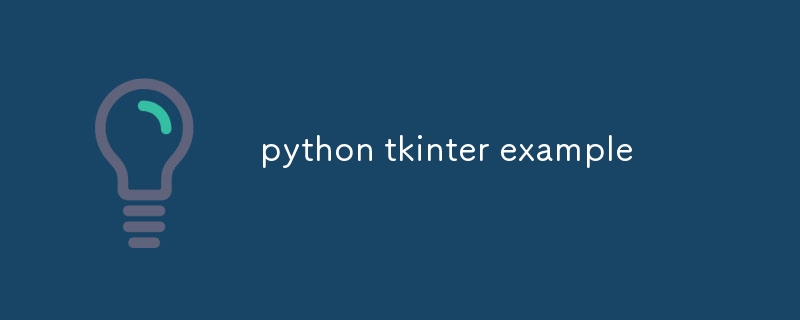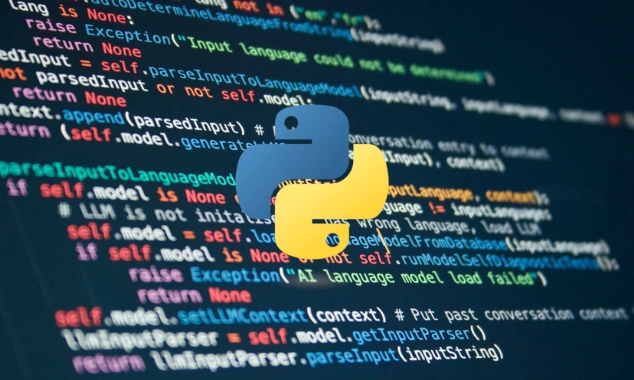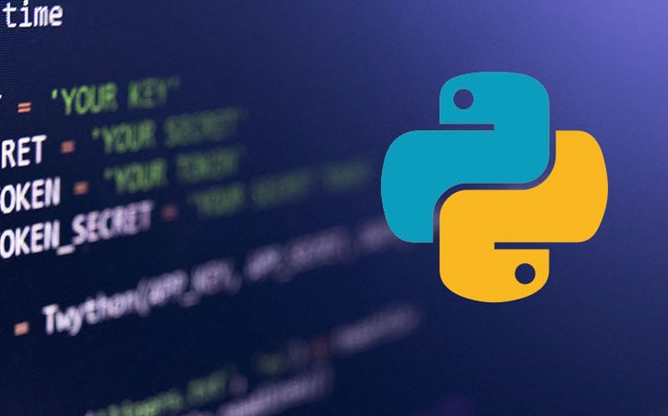python tkinter example
The program creates a simple Tkinter window, which realizes the function of clicking the button to display greetings after the user enters a name; 2. Use tk.Tk() to initialize the main window, build the interface through Label, Entry, Button and other controls, and use pack() to layout; 3. Bind the button click event to the greeting function through command=greet to realize event processing; 4. The greet function obtains the content of the input box. If it is not empty, use the config() method to update the result_label to display greetings, otherwise it will be prompted to have an error in input; 5. The program starts the main event loop through root.mainloop() and waits for user interaction; 6. Extension suggestions include using grid() instead to layout, adding clear buttons, binding Enter key events, and beautifying the interface. This is a complete basic Tkinter application example covering the core concepts of control usage, event processing, and interface updates.

Here is a practical Python Tkinter example suitable for beginners to understand basic controls and event handling. This example implements a simple "greeting program": the user enters a name, and then clicks the button to display the greeting in the window.

?️ Simple Tkinter Example: Greeting Program
import tkinter as tk
# Create main window root = tk.Tk()
root.title("Greeting App")
root.geometry("300x150") # Set window size# Tag: Prompt the user to enter label = tk.Label(root, text="Enter your name:")
label.pack(pady=10)
# Input box entry = tk.Entry(root, width=25)
entry.pack(pady=5)
# The label that displays the result result_label = tk.Label(root, text="", fg="blue", font=("Helvetica", 10))
result_label.pack(pady=10)
# Button click event handling function def greet():
name = entry.get() # Get input if name.strip():
result_label.config(text=f"Hello, {name}!")
else:
result_label.config(text="Please enter a name!", fg="red")
# Button button = tk.Button(root, text="Greet", command=greet)
button.pack(pady=5)
# Run the main loop root.mainloop()? Key points description
✅ 1. tk.Tk() creates the main window
This is the starting point for all Tkinter programs, representing the main application window.
✅ 2. Common controls
-
Label: Display text -
Entry: Single-line text input -
Button: Clickable button -
pack(): Simple layout manager (alsogrid()andplace())
✅ 3. Event binding
Bind the button click to the function via command=greet , be careful not to write it as greet() (with brackets will be executed immediately).

✅ 4. Dynamic update interface
Use the .config() method to modify control properties (such as text, color, etc.).
? Operation effect
- Open the program window
- Enter your name in the input box (such as "Alice")
- Click the "Greet" button
- The window will display:
Hello, Alice!
?️ Extension suggestions (advanced direction)
You can try this on this basis:

- Use
grid()layout instead ofpack()to control position more accurately - Add Clear button: Reset input and results
- Press Enter to trigger a greeting (bind
<return></return>event) - Change the font, background color or add icons (
.ico)
This example covers the most basic and commonly used elements of Tkinter, which is suitable for beginner GUI programming. Basically all this is it, not complicated but it is easy to ignore details, such as input verification and event binding methods.
The above is the detailed content of python tkinter example. For more information, please follow other related articles on the PHP Chinese website!

Hot AI Tools

Undress AI Tool
Undress images for free

Undresser.AI Undress
AI-powered app for creating realistic nude photos

AI Clothes Remover
Online AI tool for removing clothes from photos.

Clothoff.io
AI clothes remover

Video Face Swap
Swap faces in any video effortlessly with our completely free AI face swap tool!

Hot Article

Hot Tools

Notepad++7.3.1
Easy-to-use and free code editor

SublimeText3 Chinese version
Chinese version, very easy to use

Zend Studio 13.0.1
Powerful PHP integrated development environment

Dreamweaver CS6
Visual web development tools

SublimeText3 Mac version
God-level code editing software (SublimeText3)
 How to handle API authentication in Python
Jul 13, 2025 am 02:22 AM
How to handle API authentication in Python
Jul 13, 2025 am 02:22 AM
The key to dealing with API authentication is to understand and use the authentication method correctly. 1. APIKey is the simplest authentication method, usually placed in the request header or URL parameters; 2. BasicAuth uses username and password for Base64 encoding transmission, which is suitable for internal systems; 3. OAuth2 needs to obtain the token first through client_id and client_secret, and then bring the BearerToken in the request header; 4. In order to deal with the token expiration, the token management class can be encapsulated and automatically refreshed the token; in short, selecting the appropriate method according to the document and safely storing the key information is the key.
 How to parse large JSON files in Python?
Jul 13, 2025 am 01:46 AM
How to parse large JSON files in Python?
Jul 13, 2025 am 01:46 AM
How to efficiently handle large JSON files in Python? 1. Use the ijson library to stream and avoid memory overflow through item-by-item parsing; 2. If it is in JSONLines format, you can read it line by line and process it with json.loads(); 3. Or split the large file into small pieces and then process it separately. These methods effectively solve the memory limitation problem and are suitable for different scenarios.
 Python for loop over a tuple
Jul 13, 2025 am 02:55 AM
Python for loop over a tuple
Jul 13, 2025 am 02:55 AM
In Python, the method of traversing tuples with for loops includes directly iterating over elements, getting indexes and elements at the same time, and processing nested tuples. 1. Use the for loop directly to access each element in sequence without managing the index; 2. Use enumerate() to get the index and value at the same time. The default index is 0, and the start parameter can also be specified; 3. Nested tuples can be unpacked in the loop, but it is necessary to ensure that the subtuple structure is consistent, otherwise an unpacking error will be raised; in addition, the tuple is immutable and the content cannot be modified in the loop. Unwanted values can be ignored by \_. It is recommended to check whether the tuple is empty before traversing to avoid errors.
 Can a Python class have multiple constructors?
Jul 15, 2025 am 02:54 AM
Can a Python class have multiple constructors?
Jul 15, 2025 am 02:54 AM
Yes,aPythonclasscanhavemultipleconstructorsthroughalternativetechniques.1.Usedefaultargumentsinthe__init__methodtoallowflexibleinitializationwithvaryingnumbersofparameters.2.Defineclassmethodsasalternativeconstructorsforclearerandscalableobjectcreati
 Python for loop range
Jul 14, 2025 am 02:47 AM
Python for loop range
Jul 14, 2025 am 02:47 AM
In Python, using a for loop with the range() function is a common way to control the number of loops. 1. Use when you know the number of loops or need to access elements by index; 2. Range(stop) from 0 to stop-1, range(start,stop) from start to stop-1, range(start,stop) adds step size; 3. Note that range does not contain the end value, and returns iterable objects instead of lists in Python 3; 4. You can convert to a list through list(range()), and use negative step size in reverse order.
 Python for Quantum Machine Learning
Jul 21, 2025 am 02:48 AM
Python for Quantum Machine Learning
Jul 21, 2025 am 02:48 AM
To get started with quantum machine learning (QML), the preferred tool is Python, and libraries such as PennyLane, Qiskit, TensorFlowQuantum or PyTorchQuantum need to be installed; then familiarize yourself with the process by running examples, such as using PennyLane to build a quantum neural network; then implement the model according to the steps of data set preparation, data encoding, building parametric quantum circuits, classic optimizer training, etc.; in actual combat, you should avoid pursuing complex models from the beginning, paying attention to hardware limitations, adopting hybrid model structures, and continuously referring to the latest documents and official documents to follow up on development.
 Accessing data from a web API in Python
Jul 16, 2025 am 04:52 AM
Accessing data from a web API in Python
Jul 16, 2025 am 04:52 AM
The key to using Python to call WebAPI to obtain data is to master the basic processes and common tools. 1. Using requests to initiate HTTP requests is the most direct way. Use the get method to obtain the response and use json() to parse the data; 2. For APIs that need authentication, you can add tokens or keys through headers; 3. You need to check the response status code, it is recommended to use response.raise_for_status() to automatically handle exceptions; 4. Facing the paging interface, you can request different pages in turn and add delays to avoid frequency limitations; 5. When processing the returned JSON data, you need to extract information according to the structure, and complex data can be converted to Data
 python one line if else
Jul 15, 2025 am 01:38 AM
python one line if else
Jul 15, 2025 am 01:38 AM
Python's onelineifelse is a ternary operator, written as xifconditionelsey, which is used to simplify simple conditional judgment. It can be used for variable assignment, such as status="adult"ifage>=18else"minor"; it can also be used to directly return results in functions, such as defget_status(age):return"adult"ifage>=18else"minor"; although nested use is supported, such as result="A"i







